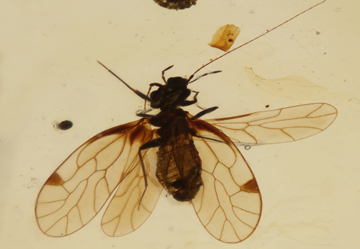Abstract
Examination of new fossil specimens of Prosyntexis from the Lower Cretaceous Crato Formation of Brazil reveled a new species namely Prosyntexis sennlaubi sp. nov. To ensure the validity of the new taxon we examined previously described and figured specimens but we also figured an additional specimen of Prosyntexis gouleti Sharkey, 1990. The new species can be differentiated from the other Prosyntexis species of the Crato formation by its larger size but also in having the cell 2R1 small, the cell 2M small and short, the cell 3R1 narrow and the vein a directed toward wing apex. We performed a Geometric Morphometric Analysis (GMA) to estimate the variation in the forewing venation of the two species from the Crato Formation and ensure our placement.
References
Barling, N., Martill, D.M., Heads, S.W. & Gallien, F. (2015) High fidelity preservation of fossil insects from the Crato Formation (Lower Cretaceous) of Brazil. Cretaceous Research, 52, 605–622.
https://doi.org/10.1016/j.cretres.2014.05.007
Darling, D.C. & Sharkey, M.J. (1990) Hymenoptera. pp. 123–153. In: Grimaldi, D.A. (Ed.), Insects from the Santana formation, Lower Cretaceous, of Brazil. Bulletin of the American Museum of Natural History, 195, 1–191.
http://hdl.handle.net/2246/943
Freitas, L.C.B., Rasnitsyn, A.P., Moura, G.J.B. & Mendes, M. (2020) New species of Myrmicium Westwood (Psedosiricidae = Myrmiciidae: Hymenoptera, Insecta) from the Early Cretaceous (Aptian) of the Araripe Basin, Brazil. Anais da Academia Brasileira de Ciências, 92, e20200479.
https://doi.org/10.1590/0001-3765202020200479
Gerstaecker, C.E.A. (1867) Über die Gattung Oxybelus Latr. und die bei Berlin vorkommenden Arten derselben. Zeitschrift fur die Gesammten Naturwissenschaft, 30, 1–96.
Jattiot, R., Krogmann, L. & Nel, A. (2011) Revision of Prosyntexis from the Lower Cretaceous Crato Formation of Brazil (Hymenoptera: Sepulcidae: Trematothoracinae). Zootaxa, 3058 (1), 55–62.
https://doi.org/10.11646/zootaxa.3058.1.4
Jouault, C., Pouillon, J-M. & Nel, A. (2020) The first fossil horntail wasp (Hymenoptera: Siricidae) from Lower Cretaceous Crato Formation in Brazil. Palaeoentomology, 3 (4), 382–389.
https://doi.org/10.11646/palaeoentomology.3.4.10
Kopylov, D.S. & Rasnitsyn, A.P. (2014) New Trematothoracinae (Hymenoptera: Sepulcidae) from the Lower Cretaceous of Transbaikalia. Proceedings of the Russian Entomological Society, 85, 199–206.
https://doi.org/10.47640/1605-7678_2014_85_1_199
Kopylov, D.S. & Rasnitsyn, A.P. (2017a) New sepulcids (Hymenoptera: Sepulcidae) from the Lower Cretaceous of Asia. I. Parapamphiliinae and Xyelulinae. Paleontological Journal, 51, 69–76.
https://doi.org/10.1134/S0031030117010087
Kopylov, D.S. & Rasnitsyn, A.P. (2017b) New sepulcids (Hymenoptera: Sepulcidae) from the Lower Cretaceous of Asia. II. Ghilarellinae and Trematothoracinae. Paleontological Journal, 51, 291–303.
https://doi.org/10.1134/S0031030117030029
Hammer, Ø., Harper, D.A.T. & Ryan, P.D. (2001) PAST: Paleontological statistics software package for education and data analysis. Palaeontologia Electronica, 4, 9.
http://palaeo-electronica.org/2001_1/past/issue1_01.htm
Linnaeus, C. von (1758) Systema Naturae per regna tria naturae secundum classes, ordines, genera, species cum characteribus, differentiis, synonymis, locis. Ed. decima reformata. Holmiae, Laur. Salvii, 1, 1–823.
https://doi.org/10.5962/bhl.title.542
Martins-Neto, R.G., Melo, A.C. & Prezoto, F. (2007) A new species of wasp (Symphyta, Sepulcidae) from the Santana Formation (Lower Cretaceous, Northeast Brazil). Journal of the Entomological Research Society, 9, 1–6.
Newman, E. (1835) The grammar of entomology. London, Frederick Westley and A.H. Davis (Publ.), i–xvi + 1–304.
https://doi.org/10.5962/bhl.title.66056
Pons, D., Berthou, P.-Y. & Campos, D.A. (1991) Quelques observations sur la palynologie de l’Aptien supérieur et de l’Albien du bassin d’Araripe (N.E. du Brésil). In: Campos, D.A., Vianna, M.S.S., Brito, P.M. & Beurlen, G. (Eds), Atas do I simposio sobre a Bacia do Araripe e Bacias Interiores do Nordeste, Crato, pp. 241–252.
Rasnitsyn, A.P. (1968) Noviye mezozoyskiye pilil’shchiki (Hymenoptera, Symphyta) [New Mesozoic sawflies (Hymenoptera, Symphyta)]. Yurskie nasekomye Karatau [Jurassic Insects of Karatau], 190–236.
Rasnitsyn, A.P. (1988) Sepul’ki i proiskhozhdenie steblevykh pilil’shchikov (Hymenoptera: Cephidae, Sepulcidae). Trudy Vsesoyuznogo Entomologicheskogo Obshchestva, 70, 68–73.
Rasnitsyn, A.P. (1993) Novye taksony sepulek (Vespida: Sepulcidae) [New taxa of Sepulcidae (Mesozoic Vespida from Asia).] pp. 80–99. In: Ponomarenko, A.G. (Ed.), Mezozoyskie nasekomye i ostrakody Azii. Trudy Paleontologicheskogo Instituta Akademii Nauk SSSR, 252, 1–160 [In Russian].
Rasnitsyn, A.P. & Ansorge, J. (2000) New Early Cretaceous hymenopterous insects (Insecta: Hymenoptera) from Sierra del Montsec (Spain). Palaeontologische Zeitschrift, 74, 335–341.
https://doi.org/10.1007/BF02988105
Rasnitsyn, A.P. & Martínez-Delclòs, X. (2000) Wasps (Insecta: Vespida = Hymenoptera) from the Early Cretaceous of Spain. Acta Geologica Hispanica, 35, 65–95.
Ribeiro, A.C., Ribeiro, G.C., Varejão, F.G., Battirola, L.D., Pessoa, E.M., Simões, M.G., Warren, L.V., Riccomini, C. & Poyato-Ariza, F.C. (2021) Towards an actualistic view of the Crato Konservat-Lagerstätte paleoenvironment: A new hypothesis as an Early Cretaceous (Aptian) equatorial and semi-arid wetland. Earth-Science Reviews, 216, 103573.
https://doi.org/10.1016/j.earscirev.2021.103573
Schneider, C.A., Rasband, W.S. & Eliceiri, K.W. (2012) NIH Image to ImageJ: 25 years of image analysis. Nature Methods, 9, 671675.
https://doi.org/10.1038/nmeth.2089
Scotese, C.R. (2014a) Atlas of Early Cretaceous Paleogeographic Maps, PALEOMAP Atlas for ArcGIS, volume 2, The Cretaceous, Maps 23–31, Mollweide Projection, PALEOMAP Project, Evanston, IL.
Scotese, C.R. (2014b) Atlas of Jurassic Paleogeographic Maps, PALEOMAP Atlas for ArcGIS, volume 4, The Jurassic and Triassic, Maps 32–42, Mollweide Projection, PALEOMAP Project, Evanston, IL.
Varejão, F.G., Warren, L.V., Simões, M.G., Buatois, L.A., Mángano, M.G., Bahniuk, A.M.R. & Assine, M.L. (2021) Mixed siliciclastic-carbonate sedimentation in an evolving epicontinental sea: Aptian record of marginal marine settings in the interior basins of north-eastern Brazil. Sedimentology, (online).
https://doi.org/10.1111/sed.12846
Zhang, H.C., Zhang, J.F. & Wei, D.T. (2001) Discovery of Trematothoracinae (Insecta) in the Upper Jurassic of W. Liaoning, China with a discussion of its phylogeny. Acta Palaeontologica Sinica, 40, 224–228.


